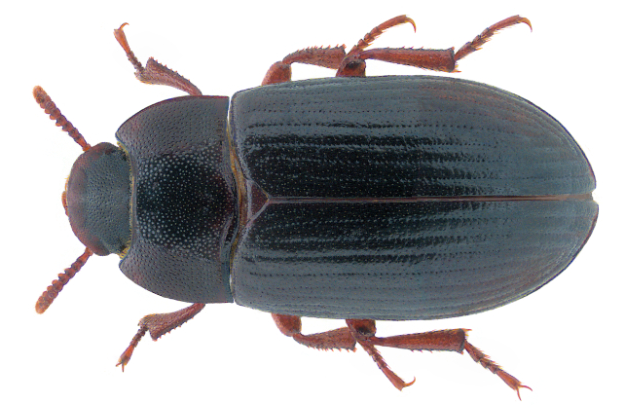Plastic-Eating Insect Discovered in Kenya: A Game-Changer for Africa’s Plastic Pollution Crisis

In a discovery that feels straight out of a sci-fi movie, scientists in Kenya have identified a plastic-eating insect species, the Kenyan lesser mealworm.
This remarkable larva, the youthful stage of the Alphitobius darkling beetle, has shown an appetite for polystyrene—yes, the same material we often call Styrofoam.

What makes this even more groundbreaking is that it’s the first African insect found to possess this unique plastic-munching ability.
Why This Matters
Plastic pollution is one of the planet’s most pressing environmental crises. Polystyrene, widely used in food containers, electronics, and industrial packaging, is notoriously tough to break down.
Traditional recycling methods—chemical and thermal processes—are expensive and often produce pollutants. Enter the Kenyan lesser mealworm, offering a potential biological solution to this global headache.
“Polystyrene is essentially indestructible in the natural environment,” explained a scientist from the International Centre of Insect Physiology and Ecology (ICIPE), who co-led the study. “Discovering a natural process to break it down is a game changer.”
The Kenyan Connection
Though lesser mealworms are found worldwide, they’re believed to have originated in Africa.
The species studied by ICIPE may even be a unique sub-species of the Alphitobius genus, and further research is underway to confirm this.
These larvae thrive in warm environments like poultry rearing houses, which provide the perfect conditions for them to grow and reproduce.
A Month-Long Experiment
Researchers conducted a month-long trial to test the larvae’s plastic-eating prowess. The larvae were divided into three groups: one fed exclusively polystyrene, another given a nutrient-rich bran diet, and a third group receiving a mix of both.

The results? Larvae on the polystyrene-bran combo diet outperformed their peers, consuming 11.7% of the polystyrene provided.
Interestingly, the polystyrene-only diet kept the larvae alive but didn’t provide enough nutrition for optimal performance. The researchers noted that the insects likely consumed polystyrene for its carbon and hydrogen—essential energy sources.
Gut Check: The Role of Bacteria
The real stars of the show might be the bacteria residing in the larvae’s guts. Analysis revealed that polystyrene-fed larvae hosted high levels of Proteobacteria and Firmicutes, microbial groups known for breaking down complex substances.
Specific bacteria like Kluyvera, Lactococcus, Citrobacter, and Klebsiella were found in abundance, producing enzymes capable of digesting synthetic plastics.
Here’s the kicker: these bacteria may not naturally exist in the larvae’s gut. Instead, their composition seems to adapt when the insects consume plastic, evolving to tackle the new diet.

This adaptability opens the door to isolating these bacteria and their enzymes for large-scale plastic degradation efforts—no insects required.
Africa’s Unique Plastic Problem
Africa faces a particularly dire plastic pollution crisis due to high importation rates, limited reuse, and insufficient recycling infrastructure.
In this context, the discovery of a local insect species with plastic-degrading abilities is especially significant. The environmental conditions in Africa—and its unique fauna—could offer solutions that differ from those developed in other parts of the world.
“The regional focus of our research is vital,” the scientist emphasized. “We’re not just tackling a global problem; we’re tailoring solutions to African contexts.”
What’s Next?
The researchers have big plans for their newfound plastic-eating allies.

Rather than releasing millions of mealworms into landfills (a logistical nightmare, not to mention gross), the team aims to harness the bacteria and enzymes in controlled environments like factories or cleanup sites.
This method could revolutionize how we manage plastic waste on a large scale.
Future studies will focus on:
- Isolating and scaling up the enzymes responsible for breaking down polystyrene.
- Testing whether these insects can tackle other types of plastics.
- Ensuring the insects remain healthy during prolonged plastic consumption.
- Assessing the safety of using insect biomass (post-plastic diet) for purposes like animal feed.
A Step Toward Hope
The Kenyan lesser mealworm is joining a growing roster of insects with plastic-degrading powers, including yellow mealworms and superworms.
But its African origins and unique bacterial toolkit make it a promising candidate for localized solutions.
This discovery is a small but significant step in addressing the plastic pollution crisis.

Who knew that a tiny, unassuming insect could hold such transformative potential? The next time you’re faced with a Styrofoam takeout container, take a moment to think of the lesser mealworm and its powerful bacterial sidekicks. They just might be the unsung heroes our planet needs.
